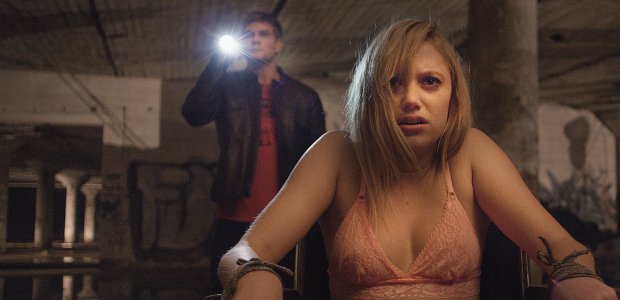What follows? That’s the mystery driving David Robert Mitchell’s creepy, unsettling and intelligently barebones horror gem It Follows, and the terrifying question will keep you guessing (and cowering) for the bulk of this film’s gripping run time.
The “It” of the title actually is a spirit (or demon, or entity… this wasn’t clarified, though the ambiguity increases the movie’s scares). “It” comes after you once you have been… well, infected. And you’re infected through sexual intercourse. Without question, this sounds bizarre, but the premise of Mitchell’s horror plays better in context. After sleeping with her relatively recent boyfriend, the wholesome suburban cutie Jay Height (Maika Monroe) learns that she’s the new target of this mysterious, menacing, predatory force. Until she can pass the curse to a new host – also through intercourse – she has to run. Perpetually. For her life.
Mitchell’s execution in It Follows is as simplistic as the film’s title, and the sinister motive of the paranormal antagonist. No matter where Jay goes, the spirit follows. She’s told by the deceiving lunk who saddles her that the stalking threat is “very slow, but it isn’t dumb.” All it does it relentlessly pursue the last person designated as the carrier, and attempt to kill him or her with the passion and intensity of the T-1000 from Terminator 2: Judgment Day.
But here’s Mitchell’s most clever decision – in a series of clever decisions – regarding It Follows. The ghostly force following Jay can look like anyone, and only she can see it. At one point, it looks like a grandmother shuffling along, eerily, in a tattered hospital gown. Sometimes, it’s a naked woman, soaking wet and dirty for reasons we’re never given. In the film’s most terrifying scene, it looks like a 7-foot man with bleach-pale skin and sunken eyes. The creature never speaks. The creature never runs. It never speaks. It grabs Jay, and occasionally defends itself from attacks. But it doesn’t break stride. It just… follows.
That sense of dread, when one is being pursued, drenches It Follows in an unshakeable gloom, and Mitchell’s terrific camerawork means that we spend the bulk of the film looking away from the action and deep into the backgrounds of scenes to see if “It” is coming. This subtle approach of spying gives It Follows a perverse, voyeuristic quality. “I see you,” Jay coolly warns the horny teenage boys who watch her while she swims in her backyard pool, not knowing how significant that idea of being watched would become in the next few days.
You could read deeper into the material in Mitchell’s own screenplay if you so desired. It Follows deliberately sets its chase in suburbia, where neighbors notoriously act paranoid as they spy on their nearest residents. You can pick up on an aura of distrust and fear in the manicured homes of this otherwise quiet zone. There’s a conversation late in the movie, when Jay and her friends are fleeing her deadly hunter, where they discuss the property line that divides their allegedly safe neighborhood from the perils of city life. The irony of the situation isn’t lost on Jay -- or those audience members who are paying close attention.
There’s also the matter of young men and women being punished for fornicating, on obvious but unavoidable subject given the unusual nature by which targets are “selected” by the “It” in It Follows. The guilty party who curses Jay says he picked it up in a bar on a late-night fling, a one-night stand. He thinks that’s where it originated, and we get very little backstory on the menacing threat beyond those words. We just know this thing exists, it hunts, it haunts, and if you fucked, it’s coming to get you.
But really, It Follows just wants to unnerve you by making a once-innocent girl the victim of an unstoppable attacker, and on that level, it works far better than most horror films available today. You know who’s going to adore every frame of It Follows? Horror-meister Wes Craven, and anyone who grew up absorbing his brand of creep-sexy chills. Craven enjoyed pulling back the artificial sheen of suburbia to expose all manner of disturbing horrors in movies like Scream, The Last House on the Left and – of course – A Nightmare on Elm Street. And not since Freddy Krueger stalked teenagers in their sleep have I felt so completely like the poor kids on screen had nowhere to run, and nowhere to hide. They never felt safe, and they were powerless to stop their supernatural tormentor. And when you can mention Nightmare on Elm Street in the same breath as any horror film, that’s damn good company to keep.

Sean O’Connell is a journalist and CinemaBlend’s Managing Editor. Having been with the site since 2011, Sean interviewed myriad directors, actors and producers, and created ReelBlend, which he proudly cohosts with Jake Hamilton and Kevin McCarthy. And he's the author of RELEASE THE SNYDER CUT, the Spider-Man history book WITH GREAT POWER, and an upcoming book about Bruce Willis.











